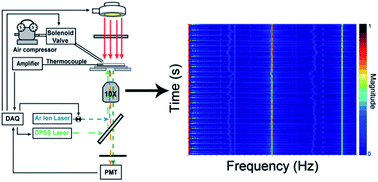Here are the top ten most accessed Analyst articles for October, November and December 2013.
Imaging live cells grown on a three dimensional collagen matrix using Raman microspectroscopy
F. Bonnier, P. Knief, B. Lim, A. D. Meade, J. Dorney, K. Bhattacharya, F. M. Lyng and H. J. Byrne
Analyst, 2010,135, 3169-3177
DOI: 10.1039/C0AN00539H, Paper
Detection of calcium phosphate crystals in the joint fluid of patients with osteoarthritis – analytical approaches and challenges
Alexander Yavorskyy, Aaron Hernandez-Santana, Geraldine McCarthy and Gillian McMahon
Analyst, 2008,133, 302-318
DOI: 10.1039/B716791A, Critical Review
Gold-coated polycarbonate membrane filter for pathogen concentration and SERS-based detection
Krista Rule Wigginton and Peter John Vikesland
Analyst, 2010,135, 1320-1326
DOI: 10.1039/B919270K, Paper
Capillary zone electrophoresis-multiple reaction monitoring from 100 pg of RAW 264.7 cell lysate digest
Liangliang Sun, Yihan Li, Matthew M. Champion, Guijie Zhu, Roza Wojcik and Norman J. Dovichi
Analyst, 2013,138, 3181-3188
DOI: 10.1039/C3AN00287J, Paper
Upconversion nanoparticles in biological labeling, imaging, and therapy
Feng Wang, Debapriya Banerjee, Yongsheng Liu, Xueyuan Chen and Xiaogang Liu
Analyst, 2010,135, 1839-1854
DOI: 10.1039/C0AN00144A, Critical Review
Single-channel electrophysiology of cell-free expressed ion channels by direct incorporation in lipid bilayers
Mark S. Friddin, Natalie P. Smithers, Maïwenn Beaugrand, Isabelle Marcotte, Philip T. F. Williamson, Hywel Morgan and Maurits R. R. de Planque
Analyst, 2013,138, 7294-7298
DOI: 10.1039/C3AN01540H, Communication
A non enzymatic glucose biosensor based on an ultrasensitive calix[4]arene functionalized boronic acid gold nanoprobe for sensing in human blood serum
Alok Pandya, Pinkesh G. Sutariya and Shobhana K. Menon
Analyst, 2013,138, 2483-2490
DOI: 10.1039/C3AN36833E, Paper
Mid-infrared spectroscopy for gases and liquids based on quantum cascade technologies
Pierre Jouy, Markus Mangold, Béla Tuzson, Lukas Emmenegger, Yu-Chi Chang, Lubos Hvozdara, Hans Peter Herzig, Philip Wägli, Alexandra Homsy, Nico F. de Rooij, Alexander Wirthmueller, Daniel Hofstetter, Herbert Looser and Jérôme Faist
Analyst, 2014, Advance Article
DOI: 10.1039/C3AN01462B, Paper
A pyrene-based simple but highly selective fluorescence sensor for Cu2+ ions via a static excimer mechanism
Soma Sarkar, Swapnadip Roy, Anindita Sikdar, R. N. Saha and Sujit S. Panja
Analyst, 2013,138, 7119-7126
DOI: 10.1039/C3AN00928A, Paper
A novel 2,6-diformyl-4-methylphenol based chemosensor for Zn(II) ions by ratiometric displacement of Cd(II) ions and its application for cell imaging on human melanoma cancer cells
Atanu Jana, Pradip K. Sukul, Sushil K. Mandal, Saugata Konar, Sangita Ray, Kinsuk Das, James A. Golen, Arnold L. Rheingold, Sudipa Mondal, Tapan K. Mondal, Anisur R. Khuda-Bukhsh and Susanta K. Kar
Analyst, 2014,139, 495-504
DOI: 10.1039/C3AN01750H, Paper
We hope you enjoyed reading these articles, and if you have any thoughts or comments, please leave these in the comment box below.
Fancy submitting an article to Analyst? Why not submit to us here today or alternatively email us your suggestions!


























